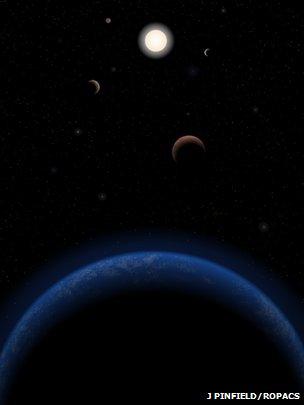Tau Ceti's planets nearest around single, Sun-like star
- Published

Our nearest single Sun-like star hosts five planets - one of which is in the "habitable zone" where liquid water can exist, astronomers say.
Tau Ceti's planetary quintet - reported in an online paper that will appear in Astronomy and Astrophysics - was found in existing planet-hunting data.
The study's refined methods of sifting through data should help find even more far-flung worlds.
The star now joins Alpha Centauri B as a nearby star known to host planets.
Tau Ceti lies 12 light-years distant; Alpha Centauri B, just four. In both cases, the planets were found not by spying them through a telescope but rather by measuring the subtle effects they have on their host stars' light.
In the gravitational dance of a planet around a star, the planet does most of the moving. But the star too is tugged slightly to and fro as the planet orbits, and these subtle movements of the star show up as subtle shifts in the colour of the star's light we see from Earth.
This "radial velocity" measurement is a tricky one; stars' light changes also for a range of other reasons, and requires picking out the specifically planetary component from all this "noise".
Now, Hugh Jones of the University of Hertfordshire and colleagues have refined their "noise modelling" in order to subtract it, and thereby see the smallest signals hiding in the data - starting with Tau Ceti.
"It's a star on which we have a lot of data - an order of magnitude more data than we have for pretty much any other star," Prof Jones told BBC News.
"It's a good test case for how low can we go, what size of signals can we pick up."
The trick to honing the technique was to put in "fake planets" - to add signals into the messy data that planets should add - and find ways to reduce the noise until the fake planets became more and more visible in the data.
"Putting all that together, we optimised a noise-modelling strategy which allows us to recover our fake signals - but in the process of doing that, we actually saw that we were finding signals as well," Prof Jones said - actual planets.
The quintet includes planets between two and six times the Earth's mass, with periods ranging from 14 to 640 days.
One of them, dubbed HD 10700e, lies about half as far from Tau Ceti as the Earth is from the Sun - and because Tau Ceti is slightly smaller and dimmer than our Sun, that puts the planet in the so-called habitable zone.
It is increasingly clear that in existing data from radial velocity measurements there may be evidence of many more planets.
On Monday, Philip Gregory at the University of British Columbia in Canada posted an as-yet unpublished paper to the arXiv repository, claiming to have seen three planets in the habitable zone of Gliese 667C, one of three stars in a triple-star system, 22 light-years away.
It is also clear that in almost every direction we look and in every way that we look, there are planets around stars near and far.
The catalogue currently stands at 854 confirmed planets, and is growing with every new publication.
- Published8 November 2012
- Published17 October 2012
- Published28 July 2012
- Published28 March 2012